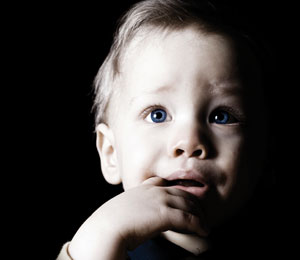 Childhood can be a scary place. Creepy, crawly creatures, monsters under the bed, a barking dog, a dark room where you’re all alone — these are common scenarios that can evoke real fear, phobias and anxiety in small children.
Childhood can be a scary place. Creepy, crawly creatures, monsters under the bed, a barking dog, a dark room where you’re all alone — these are common scenarios that can evoke real fear, phobias and anxiety in small children.
Usually, all it takes is a little reassurance from mom or dad to make things all better. But for some children that cope with worrying more regularly, it’s complicated. These are kids for whom normal childhood fears can turn into anxieties, often casting a shadow over their lives.
Anxiety is the single most commonly diagnosed mental health condition in children, according to Seattle psychologist Christopher McCurry, the author of Parenting Your Anxious Child with Mindfulness and Acceptance. McCurry says that between 6 percent and 20 percent of children have a diagnosable anxiety disorder. But since virtually every child experiences some anxiety, how do parents know when there’s a problem? McCurry says to look for these four factors:
- Intensity: Is your child’s anxious reaction way out of proportion to events or situations?
- Frequency: Is your child having some sort of anxious episode every day?
- Duration: How long does the event last? How long does it take to recover?
- Interference in day-to-day life: Is your child avoiding sleepovers or birthday parties, or even refusing to go to school?
“[Anxiety] has to do with the anatomic arousal system. Some kids are temperamentally wired to be reactive; others are not,” says Dr. Matthew Speltz, professor of psychiatry and behavioral sciences at the University of Washington School of Medicine, and clinical director of child and adolescent outpatient psychiatry at Seattle Children’s Hospital.
“A tolerance for discomfort is important,” Speltz says. “Some people can be pretty anxious and just slog through it. Other people have a low threshold for discomfort.”
Genetics can play a role in anxiety, so anxious children often have anxious parents, Speltz says. But parents can learn strategies that can help their children through their anxieties. “It’s good to be empathetic, but not to be part of making it easy for the kid to avoid a situation,” he says. “Offer a lot of encouragement to push through.”
If a child’s world is getting smaller and smaller because of anxiety, parents may want to seek professional help, experts say.
How parents cope
“Jan,” a Mercer Island mom who asked not to have her real name used, says she calls on a variety of skills to help her daughter with anxiety during difficult times. When her daughter was 5, she became overwhelmed with worry that she would miss the bus for kindergarten. Never mind that it stopped right in front of her house or that she was up by 6:30 a.m. to catch the bus at 8:45.
Jan came up with the idea of making a checklist of all the things the little girl needed to do to get ready: get dressed, eat breakfast, brush her teeth, brush her hair. How did the mother know that would help? “Unfortunately, the apple doesn’t fall far from the tree,” Jan says. “I knew that lists have been helpful to me, so they were probably going to help her.”
Jan and her daughter also make sure they arrive at birthday parties at least five minutes early so they can be among the first ones there. “If we show up at a birthday party and there are already 15 kids there, it’s stimulation overload,” she explains. Although she makes some concessions to ease her child’s anxiety, Jan says there are rules she won’t bend. When her daughter disliked her second-grade teacher and didn’t want to go to school, she had to go anyway, even though it meant many difficult Sunday nights. “Our job as parents is to teach our children independence,” Jan says. “It’s a matter of not playing into their fears, not allowing them to manipulate you.”
School has also been a challenge for Seattle mom “Shelly” (not her real name) and her 8-year-old daughter, whose anxiety takes the form of a nervous cough or throat clearing. Her behavior often gets her sent to the “quiet table” or the principal’s office by her teacher.
“[The principal] wants my child to toe the line, and she just can’t,” Shelly says. “In the beginning, I wanted her out of there. But then I decided this is going to be a learning experience for us. I wanted her to see that we stick things out in our family. We’re going to do our best.”
Shelly also tries hard to create an environment at home to help ease her daughter’s anxiety. She’s found that long walks, trips to the park, having a quiet time every evening, avoiding television, eating a healthful diet and getting enough sleep are important. “If we can do something calming, something that produces a little peace for her, then we’re golden,” she says.
When her daughter’s anxiety first appeared, Shelly worried that it resulted from an earlier trauma — her daughter lost her dad to cancer when she was only 2 years old. Shelly consulted her pediatrician and a child psychologist, who agreed her daughter was suffering from anxiety, but it probably was unrelated to her father’s death. Later, she discovered a genetic link. One of her late husband’s sisters had suffered from anxiety, also expressed in throat clearing and coughing.
“My hope for her is that she outgrows this,” Shelly says. “I haven’t quite figured out yet what to do if she doesn’t.”
Setting goals
McCurry says he often acts as a coach for parents and kids in dealing with anxiety problems. “It’s good just to have somebody else take a look at the situation,” he says. “I work with parents to get them feeling competent and confident.”
In his book, McCurry urges parents to set goals for their anxious child, such as going to school or attending a birthday party. Parents are told to accept the child’s negative thoughts and feelings in the moment, but not to try to control them. “There’s a saying ‘If you’re going through hell, keep going,’” McCurry says. “Thoughts and feelings may not go away, but they will retreat into the background.”
He describes techniques (such as “Darth Vader breathing”) that anxious kids can use to gain control over their reactions. “The exercises reorient us to what we truly have control over: our actions. They can also take the edge off those biologically driven reactions,” McCurry says.
The big challenge is for parents to change their own reactions to a child’s anxiety. That also takes practice. The most important step is acknowledging how a child is feeling in the moment. “Say, ‘I wonder if you’re feeling anxious right now,’” McCurry advises. “Then, unless the house is on fire, take 30 seconds to let your child respond. Don’t just do something, stand there.”
That gives the child an opportunity to come up with a solution himself. For parents who are used to jumping into a situation, that may be the hardest part of all.
Experts say that if parents determine their child needs professional help, there is an excellent chance that treatment will be successful. A recent study published online in The New England Journal of Medicine found that 81 percent of children ages 7 to 17 improved after 12 weeks of treatment with medication and therapy.
Parents who have anxious children know that it can be frustrating and downright exhausting. “It’s definitely challenging, but I wouldn’t change it,” one mom says. “I would not change one thing about her.”
Elaine Bowers is a Seattle writer and mother.











